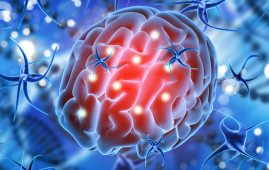

Habits are brain shortcuts. In the correct circumstances, putting on a seat belt when we get into a car becomes a habit. Habits can be bad. Stanford Medicine researchers and partners found that binge eating disorders are caused by the same neurological circuitry as buckling up.
Researchers used brain imaging to look for changes in the neural circuitry that supports habit formation in persons with binge eating disorders, which entail eating an excessive amount of food in a short period of time. In individuals with more severe problems, the discrepancies were more evident. The experts believe that the habitual nature of these disorders contributes to their difficulty in treatment.
“A habit is a learned association. Maybe initially the behavior started to achieve a goal, but eventually you’ve done it so many times that you do the action without thinking about the outcome,” said Allan Wang, a medical student at the Stanford School of Medicine and lead author of the study, which was published March 29 in Science Translational Medicine.
“We were interested in whether habit formation in the brain might be involved in a complicated behavior like binge eating,” Wang said.
Keeping Track of the Habit
Binge eating disorders appear to be habit-forming. Context can trigger episodes, whether it is external, such as the smell of food or an alluring advertising, or internal, such as feelings of melancholy or irritation. People suffering from these diseases also experience a loss of control over their behavior, which occurs in maladaptive habits ranging from nail biting to drug addiction.
However, it remained unknown if these illnesses were caused by the brain circuitry of habits.
To discover out, the researchers examined MRI images from the Human Connectome Project, a large-scale project funded by the National Institutes of Health that aims to map the brain circuits that underpin human actions. They concentrated on the striatum, which has previously been linked to habits, and a specific component of the striatum called the sensorimotor putamen, which connects to brain regions that govern sensation and movement. They expected that the sensorimotor putamen would be important in habitual behavior based on these relationships.
The researchers then collected fMRI data, which monitors brain activity, from 34 persons with binge eating disorder and 22 healthy controls. The participants were all female. They responded to questions about the frequency of their binges as well as whether they were triggered by external or internal sources.
People with binge eating disorders had significant alterations in the sensorimotor putamen’s neuronal connections with many brain regions when compared to healthy controls, validating the researchers’ hypothesis. They had stronger connections with the motor cortex, which is responsible for movement, and the orbitofrontal cortex, which is responsible for evaluating reward value, such as how good a food tastes. They exhibited less connections to the anterior cingulate cortex, which controls self-control.
The severity of their illness was mirrored in the magnitude of their deviations, regardless of whether the binges were externally or inwardly induced.
“Possibly, there’s some loss of self-regulation of this behavior,” Wang said. “At the same time, there’s increased strength of circuits involved in the motor behavior of binge eating.”
Getting Rid of Bad Habits
Further imaging investigations demonstrated that patients with more disrupted habit circuits had reduced dopamine binding, or dopamine sensitivity, in these brain regions. This suggests a mechanism underlying these anomalies: The sensory putamen communicates with the brain via dopamine, a neurotransmitter, therefore alterations in dopamine sensitivity can affect these connections, according to Wang. Furthermore, persistent high levels of dopamine during repeated exposure to pleasant stimuli can result in diminished dopamine sensitivity.
“Our findings suggest that the more dopamine exposure these patients have had in the context of binge eating, the more altered their overall habit circuit connectivity is,” he said.
Wang believes that habit circuitry is a factor in addiction and other psychiatric diseases. Understanding how neuronal connections break down in these situations could help guide specific therapies like deep brain stimulation, which utilizes electric currents administered to the brain to change neural activity.
“I think there’s also some mental benefit for patients in being able to reframe these behaviors as rooted in habit,” Wang said. “Eating disorders are not a fault of their personality. They’re related to physical changes in the brain.”
Whether people with binge eating disorders are more inclined toward other habits, good or bad, is an open question. “But it’s interesting to think about,” he said.
more recommended stories
 Senescence in Neurons: Findings
Senescence in Neurons: FindingsBased on a new study by.
 Balanced Diet Linked to Enhanced Brain Health
Balanced Diet Linked to Enhanced Brain HealthDiet and brain health are strongly.
 Acid-Reducing Drugs Linked to Higher Migraine Risk
Acid-Reducing Drugs Linked to Higher Migraine RiskIndividuals who utilize acid-reducing drugs may.
 Atrial Fibrillation in Young Adults: Increased Heart Failure and Stroke Risk
Atrial Fibrillation in Young Adults: Increased Heart Failure and Stroke RiskIn a recent study published in.
 Neurodegeneration Linked to Fibrin in Brain Injury
Neurodegeneration Linked to Fibrin in Brain InjuryThe health results for the approximately.
 DELiVR: Advancing Brain Cell Mapping with AI and VR
DELiVR: Advancing Brain Cell Mapping with AI and VRDELiVR is a novel AI-based method.
 Retinal Neurodegeneration in Parkinson’s Disease
Retinal Neurodegeneration in Parkinson’s DiseaseBy measuring the thickness of the.
 Epilepsy Seizures: Role of Astrocytes in Neural Hyperactivity
Epilepsy Seizures: Role of Astrocytes in Neural HyperactivityRoughly 1% of people experience epilepsy.
 Role of Engineered Peptides in Cancer Immunotherapy
Role of Engineered Peptides in Cancer ImmunotherapyIn a recent publication in Nature.
 CRISPR-Cas9 Gene Therapy for Prostate Cancer
CRISPR-Cas9 Gene Therapy for Prostate CancerIn their preclinical model, the researchers.

Leave a Comment